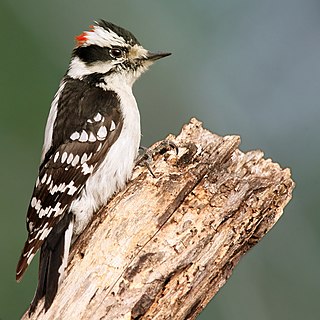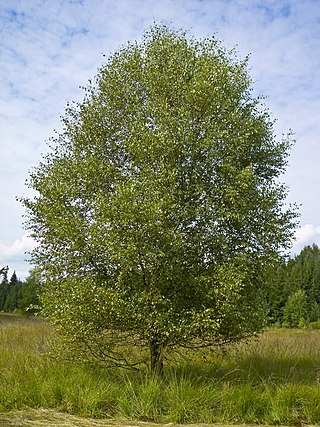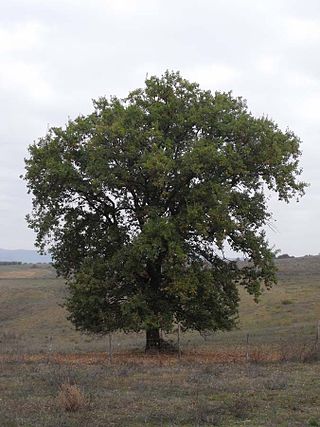
The downy woodpecker is a species of woodpecker, the smallest in North America. Length ranges from 14 to 18 cm. Downy woodpeckers primarily live in forested areas throughout the United States and Canada, with the exception of deserts in the southwest and the northern tundra. The bird nests in tree cavities and feeds primarily on insects, although it supplements its diet with seeds and berries. The downy woodpecker is very similar in appearance to the hairy woodpecker, although they are not closely related.

Betula pubescens, commonly known as downy birch and also as moor birch, white birch, European white birch or hairy birch, is a species of deciduous tree, native and abundant throughout northern Europe and northern Asia, growing farther north than any other broadleaf tree. It is closely related to, and often confused with, the silver birch, but grows in wetter places with heavier soils and poorer drainage; smaller trees can also be confused with the dwarf birch.

Capsicum pubescens is a plant of the genus Capsicum (pepper). The species name, pubescens, refers to the hairy leaves of this pepper. The hairiness of the leaves, along with the black seeds, make Capsicum pubescens distinguishable from other Capsicum species. Capsicum pubescens has pungent yellow, orange, red, green or brown fruits.

Quercus pubescens, commonly known as the downy oak, pubescent oak or Italian oak, is a species of white oak native to southern Europe and southwest Asia. It is found from northern Spain (Pyrenees) and France in the West to Turkey and the Caucasus in the East.

The mountain papaya also known as mountain pawpaw, papayuelo, chamburo, or simply "papaya" is a species of the genus Vasconcellea, native to the Andes of northwestern South America from Colombia south to central Chile, typically growing at altitudes of 1,500–3,000 metres (4,900–9,800 ft).
Serixia is a genus of longhorn beetles of the subfamily Lamiinae, containing the following species:
Hypericum pubescens is a perennial herb in the Hypericaceae family. It is in the section Adenosepalum.
Serixia buruensis is a species of beetle in the family Cerambycidae. It was described by Stephan von Breuning in 1958.
Serixia cinereotomentosa is a species of beetle in the family Cerambycidae. It was described by Stephan von Breuning in 1958.
Serixia matangensis is a species of beetle in the family Cerambycidae. It was described by Stephan von Breuning in 1958. It is known from Borneo.
Serixia novaebritanniae is a species of beetle in the family Cerambycidae. It was described by Stephan von Breuning in 1958.
Serixia sarawakensis is a species of beetle in the family Cerambycidae. It was described by Stephan von Breuning in 1958. It is known from Borneo.
Serixia flavicans is a species of beetle in the family Cerambycidae. It was described by Stephan von Breuning in 1950. It is known from Borneo.
Serixia nilghirica is a species of beetle in the family Cerambycidae. It was described by Stephan von Breuning in 1963.
Serixia longicornis is a species of beetle in the family Cerambycidae. It was described by Francis Polkinghorne Pascoe in 1858.
Serixia prolata is a species of beetle in the family Cerambycidae. It was described by Francis Polkinghorne Pascoe in 1858.
Serixia sedata is a species of beetle in the family Cerambycidae. It was described by Francis Polkinghorne Pascoe in 1862.
Serixia phaeoptera is a species of beetle in the family Cerambycidae. It was described by Per Olof Christopher Aurivillius in 1927.
Serixia atritarsis is a species of beetle in the family Cerambycidae. It was described by Maurice Pic in 1929.
Serixia inconspicua is a species of beetle in the family Cerambycidae. It was described by Gardiner in 1936.




